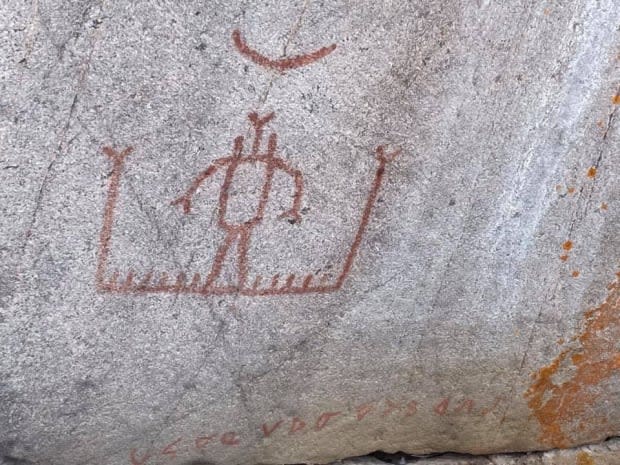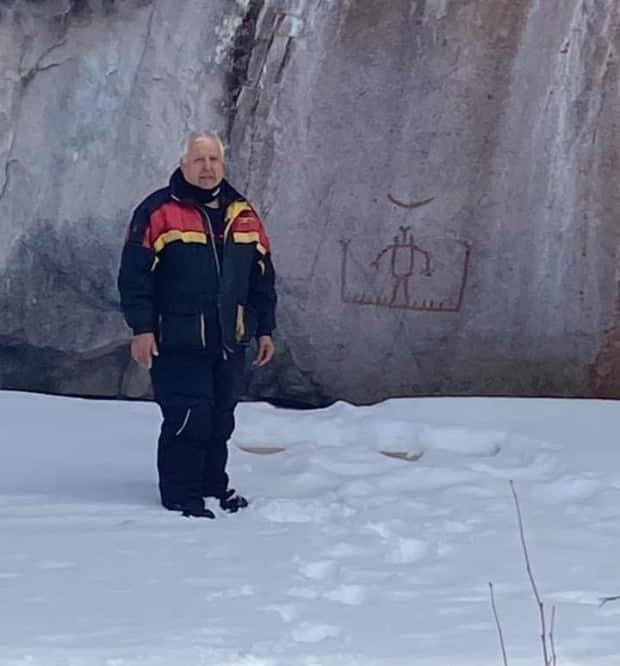Letter from 1929 offers clues about origin of drawing on rock outside Fort Smith

It's a mystery Richard Mercredi has been trying to solve for some time now.
Not far from the main trail to his cabin outside of Fort Smith, N.W.T., there is a drawing of what appears to be a person, etched in red onto a piece of rock.
"The picture is perfectly clear," said Mercredi. "I'm not sure if that's a canoe or a vessel of some kind that he's standing in … and looks like a moon over top."
Mercredi said his father showed it to him, for the first time, in the '60s.
He believes the drawing predates the time his father started trapping in the area in the 1930s. The retired Fort Smith elder also remembered hearing people talk about it when he was a kid.
"Those people were older than my dad too, so it's been there a long time."
Mercredi and his wife, Barb, took photos of the drawing and shared them with CBC hoping for answers to their decades-old questions about who marked the rock and why.
And although he wasn't able to provide specific answers, Glen MacKay, a territorial archeologist with the Prince of Wales Northern Heritage Centre, was able to provide some context.
92-year-old letter contains a theory
After seeing photos of the drawing online, MacKay said he took a look through the centre's files and found a letter, dated Jan. 10, 1929, from an RCMP officer posted in Fort Smith.

The letter says the drawing is "very old" and was painted by Cree pursued by the Tlicho Dene.
"This information was furnished to me by the Chipewyan Chief 'Old Squirrel,'" it reads. It goes on to say the Tlicho, "seeing this design or drawing, abandoned their pursuit."
The letter also says the chief, himself, added the syllabics at the bottom.
"The first line only of this writing is visible and reads: 'Here is the story of a Cree written a long time ago.'"
The letter indicates there are two or three lines below the first line, which are "indistinct."
It is addressed to a Mr. Marius Barbeau in Ottawa. According to The Governor General of Canada's website, an ethnologist and folklorist of the same name, from Ottawa, was posthumously awarded the Order of Canada in 1967 for writing that "raised awareness of the cultural heritage of the first inhabitants of Canada."
MacKay said during the times of the early fur trade in the early- to mid-19th century, there were tensions between the Cree and the Dene as Cree fur traders moved further north for trapping opportunities.
"That may play into this story … but we don't really know much more about it," he said.
Mercredi suspected the drawing was written in red ochre. That, said Mackay, is correct.
"Red ochre is a very common mineral that was used to create rock art all over the world. I think it, mixed with rendered animal fat or something along those lines, created a nice paint."
N.W.T.'s 'amazing' archeological record
MacKay said it would be great to learn more about the drawing, and to collaborate with elders in Fort Smith and learn from the knowledge they carry.
"It's part of the history of the N.W.T., so it's really important that we learn about it and celebrate it, and be able to provide that information to the people of the N.W.T."
MacKay encourages anyone who finds a drawing or an artifact not to touch it, but to take a photo of it, mark it on a map or determine its GPS coordinates if possible, and submit that information to the Prince of Wales Northern Heritage Centre.
"That gives us the opportunity, by putting that in our database, to better protect those sites in the future if there's a road being built or something like that."
Mercredi believes the drawing has been preserved so well because of its distance from town and the nature of the rock's surface.
"The rock face is just undercut a little bit, so any water that runs off doesn't seem to affect it at all," he said. "I was actually teasing my wife, said maybe it's a UFO picking [the figure] up. He wouldn't have time to draw, if it was!" he laughed.
MacKay, meanwhile, said there are likely more drawings and artifacts to be found.
"I think there is this amazing archeological record still to be discovered in the N.W.T.," he said.
"We've only scratched the surface."

 Yahoo Movies
Yahoo Movies 